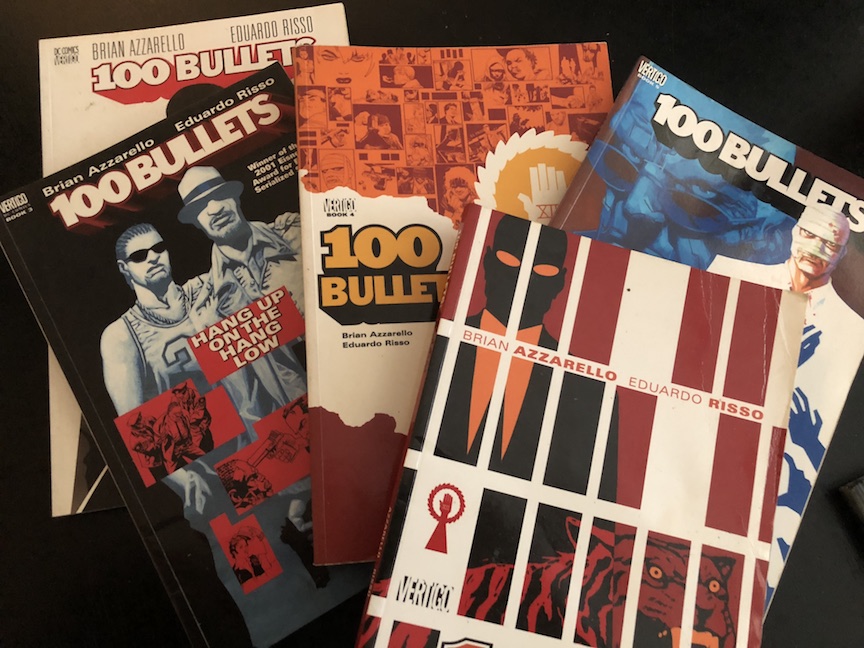For decades after the debut of Superman, comic books were all about men and women in tights fighting to save the world or the universe from the forces of evil. When DC Comics debuted its VERTIGO imprint in 1993, it completely changed the shape of the comic book industry.
On my shelf of graphic novels and collected editions, Vertigo takes up a good chunk of the comic books I own. Many of the amazing stories that have come out of the imprint have proven to be iconic and eminently re-readable. The art is frequently groundbreaking and the words on the page are nothing short of extraordinary. With Halloween on the horizon, I’ll be spending the next few days looking at some of my favorite series from Vertigo.
In this third edition of VISIONS OF VERTIGO, it’s time to gather up the attache case as we explore a tale of crime, power, revenge and what happens when those three things collide.
When the first issue of 100 BULLETS, written by Brian Azzarello with art by Eduardo Risso, debuted in comic book shops in the first half of 1999, it kicked off a 10-year story with a captivating first issue that drew readers in, as the mysterious Agent Graves approaches a seemingly normal person and makes an intriguing offer: an attache case filled with an untraceable gun, 100 untraceable bullets and the photo of the person who destroyed your life, complete with evidence to prove they did it. What the person who received the case did after they opened it was up to them – seek revenge? Try and make things better for themselves? Or just shoot people at random?
And who were the people who were given the attache by Graves? The agent wasn’t just picking people at random. He was trying to rebuild his team, deactivated years beforehand. His Minutemen were the enforcers for The Trust, a cabal of the richest people in the country. When Graves refused to follow orders from the Trust, he disbanded the Minutemen and sent them into hiding. Graves’ “game” served as a way of waking some of them up and enlisting them back into service AGAINST the Trust.
Being some of the richest families in the country, though, The Trust had resources of their own, and went about opposing Graves’ plans.

Graves was the first of a number of memorable characters that Azzarello and Risso introduced: “Dizzy” Cordova, the first person offered the briefcase in the series, a gangbanger who seeks revenge on the crooked cops who killed her husband and son; Cole Burns, the former Minuteman who served as Graves’ right-hand man after being reactivated by a junkie whispering “Croatoa”to him; “Loop” Hughes, a Philly teenager who gets caught up in Graves’ war when he tried to get to know his estranged father, a former Minuteman; and Lono, a sadistic former Minuteman who became a Warlord for the Trust.
The story of 100 BULLETS lived the gimmick, going 100 issues from June 1999 to April 2009, which put Azzarello on the map as a premiere comic book writer. His gritty storytelling, planned out in 3- to 6-issue arcs, drew people in to the book’s lore. Combined with Risso’s art, which captured the feel of the writing perfectly, and it’s easy to see why the book became as popular as it was.
As a story with a defined and built-in end-point, 100 BULLETS tends to fall into a familiar trap – the build-up is exciting, but the payoff tends to be disappointing. Many feel – and I am one of them – that the book ran out of steam well before the final issue and dragged things out too far in order to hit the predetermined end point. But that doesn’t take away from the classic storytelling that came with the first two-thirds of the story’s 100 issues.
One of the thingsI loved about reading 100 BULLETS in collected editions was the naming conventions of those editions, with each book’s title incorporating the volume number, or at least an allusion to it. From FIRST SHOT, LAST CALL (Book 1) to A FOREGONE TOMORROW (Book 4) to SAMURAI (Book 7) to DIRTY (Book 12), the titles of the collected editions gave readers something to think about. My favorite? Book 13, titled WILT, after basketball legend Wilt Chamberlain’s number; or maybe Book 11 – ONCE UPON A CRIME (the number 11 is once in Spanish).
The only book of the original collected numbering that didn’t follow the convention was Book 3 – HANG UP ON THE HANG LOW, because the story arc won an Eisner Award, and Vertigo wanted to capitalize on that with the publication of the third collection.
Despite it’s limping to the finish line, 100 BULLETS was an amazing story that – like many Vertigo properties – has frequently been on a slate for movie, TV or video game adaptations, only to see things eventually fall apart. I hope it does get adapted some day, I think it could prove to be an amazing 100 episodes of television.
